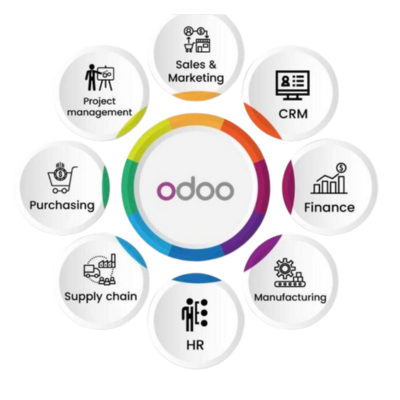Implementing Odoo ERP can significantly optimize and automate business processes, but a common question among organizations is, “How long will the Odoo implementation process take?” The answer depends on various factors, from project scope and business complexity to the degree of customization needed. In this blog, we’ll dive deep into the different phases of Odoo implementation, the factors affecting the timeline, and best practices for a smoother, faster rollout.
Introduction to Odoo Implementation Timeline
- Why Implementation Time Matters: ERP implementations are often resource-intensive, and a long timeline can affect business operations and project costs.
- Statistics on ERP Implementations: According to studies, over 75% of ERP implementations take longer than initially planned. Understanding what affects the timeline can help set realistic expectations and milestones.
1. Key Phases of Odoo Implementation
The timeline for Odoo implementation can be broken down into several essential phases, each impacting the overall duration.
Phases Overview:
Phase | Description | Average Duration |
Requirements Gathering | Identifying specific business needs and goals | 1-2 weeks |
System Design | Customizing and configuring Odoo modules | 1-3 weeks |
Development | Customizations and integration with other tools | 3-6 weeks |
Testing | System and user acceptance testing | 2-4 weeks |
Training | End-user training for smooth adoption | 1-2 weeks |
Go-Live & Support | Deployment and initial support | 1 week |
Also Read: Enhancing Customer Retention for Dealerships with Odoo CRM
2. Factors Affecting Odoo Implementation Time

a. Scope of Implementation
Impact: The scope (number of modules, users, and integrations) greatly affects the duration.
- Single Module vs. Full
- ERP: Implementing one module (e.g., CRM) may only take a few weeks, whereas a full ERP solution can take several months.
- How to Mitigate: Define a phased approach, implementing high-priority modules first and rolling out additional ones later.
b. Level of Customization
Impact: Extensive customization, from UI changes to custom workflows, adds to the project time.
- Custom vs. Standard Modules: Using Odoo’s out-of-the-box features is faster than extensive customizations, which require development and testing.
- How to Mitigate: Prioritize essential customizations and consider using standard features where possible.
Key Stats:
- Projects with heavy customization often see 40% longer timelines than those using standard configurations. (Source: Panorama Consulting)
c. Data Migration Needs
Impact: Migrating data from legacy systems can be time-consuming, especially if data needs cleaning or restructuring.
- Legacy System Complexity: Older systems with unstructured data require extensive mapping, adding to the timeline.
- How to Mitigate: Conduct a data audit beforehand and plan data cleaning in advance.
d. Testing and Quality Assurance
Impact: Inadequate testing often leads to post-go-live issues, requiring time to troubleshoot.
- Comprehensive Testing Needs: The more complex the setup, the more time is needed for thorough testing.
- How to Mitigate: Allocate sufficient time for end-user and quality assurance testing.
e. User Training and Adoption
Impact: Training is critical to ensure that staff can use the system efficiently, impacting overall timelines.
- Training Variance: Larger teams or more complex modules may need multiple training sessions.
- How to Mitigate: Identify power users and conduct role-based training to streamline the process.
f. Vendor or Consultant Experience
Impact: Experienced consultants streamline processes, reducing potential delays.
- How to Mitigate: Choose an implementation partner with proven experience in your industry and Odoo-specific expertise.
Table: Average Odoo Implementation Times by Project Scope
Project Scope | Modules Involved | Average Duration |
Basic Setup | CRM, Sales, Inventory (Standard) | 4-6 weeks |
Medium Implementation | CRM, Sales, Inventory, Accounting | 8-12 weeks |
Full ERP | Full suite (customized) | 12-20+ weeks |
3. Typical Timeline Estimates for Odoo Implementation

Small Businesses (Single Module)
- Scope: Usually one module, like CRM or Sales.
- Timeline: 4-6 weeks
- Key Activities: Requirements analysis, configuration, minimal customization, testing, and training.
- Expected Challenges: Primarily involves user adoption and basic training.
Medium Businesses (Multi-Module)
- Scope: Multiple modules with standard workflows, like Inventory, Sales, and Accounting.
- Timeline: 8-12 weeks
- Key Activities: System design, moderate customization, data migration, extensive testing, and training.
- Expected Challenges: Data migration and integration complexities, team-wide training needs.
Large Enterprises (Full ERP)
- Scope: Full ERP suite, often customized heavily with third-party integrations.
- Timeline: 12-20+ weeks
- Key Activities: Extensive customization, advanced data migration, integration with existing tools, user acceptance testing, training across multiple departments.
- Expected Challenges: High complexity due to custom workflows, managing multiple stakeholders, ensuring seamless integration.
Also Read: Automating Online Store Management Using Odoo E-Commerce Module
4. Best Practices for Reducing Odoo Implementation Time
- Set Realistic Expectations: Develop a timeline based on the unique requirements of your organization.
- Leverage Odoo’s Out-of-the-Box Features: Prioritize standard features over customization where feasible.
- Involve Key Stakeholders Early: Gather input from relevant departments to streamline decision-making.
- Implement in Phases: Use a phased approach, starting with high-priority modules and gradually expanding.
- Conduct Parallel Testing and Training: Save time by running testing and training concurrently.
Bullet Points: Top Tips to Speed Up Odoo Implementation
- Define and document clear requirements.
- Minimize unnecessary customizations.
- Use agile project management methodologies.
- Regularly communicate progress to all stakeholders.
5. Odoo Implementation Timelines
Example 1: Small Business CRM Implementation
- Company: Small Retailer
- Modules: CRM, Sales
- Timeline: 4 weeks
- Key Challenges: User adoption and initial data migration.
Example 2: Medium-Sized Business Multi-Module Setup
- Company: Manufacturing SME
- Modules: Inventory, Sales, Accounting
- Timeline: 10 weeks
- Key Challenges: Data migration from an outdated legacy system, integration with existing software.
Expert Odoo ERP Solutions Provider
Hire Expert Odoo Developers for Tailored ERP Solutions Today!

Conclusion
The duration of an Odoo implementation varies based on business needs, customization, and complexity. While small businesses may complete implementation in under two months, larger enterprises with customized requirements may need several months to go live. By understanding the factors that affect timelines and following best practices, organizations can set realistic expectations and ensure a smoother, timely rollout of their Odoo ERP system.
Also Read:
FAQs
How long does an Odoo implementation typically take?
A standard Odoo implementation can take anywhere from 2 to 6 months. Smaller projects or out-of-the-box setups might be on the shorter end of that range, while larger, more customized projects might take longer.
What factors affect the implementation timeline?
Key factors include:
- The number of Odoo modules being implemented (Sales, Accounting, Inventory, etc.).
- The level of customization required.
- Data migration and integration with other systems.
- The number of users and their training needs.
- The readiness and availability of internal resources (such as project managers or department leads).
Can Odoo be implemented faster if the business is smaller or less complex?
Yes, smaller businesses or simpler use cases can often see faster implementations, especially if they’re adopting standard, out-of-the-box features with minimal customization.
What is the process for implementing Odoo?
The process typically involves:
- Discovery/Analysis: Understanding business needs and mapping them to Odoo modules.
- Configuration: Setting up Odoo to meet business requirements.
- Customization: Developing custom features if needed.
- Data Migration: Moving data from legacy systems to Odoo.
- Integration: Linking Odoo with other systems, if applicable.
- Testing & Training: Ensuring the system works as expected and training end-users.
- Go Live & Support: Transitioning to live operation and offering ongoing support.
How can I speed up the Odoo implementation process?
Some ways to speed up the process include:
- Clearly defining your requirements from the start.
- Limiting customizations (sticking to standard Odoo features as much as possible).
- Engaging with a certified Odoo partner or expert for smoother implementation.
- Ensuring good communication and collaboration between your team and the implementation partner.















